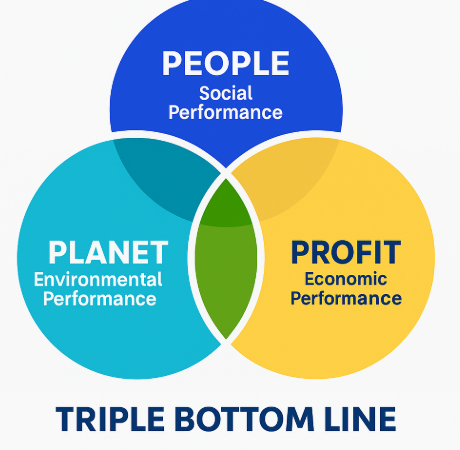For much of the 20th century, business performance was judged by one overriding metric—financial return. As long as a company could generate profit and satisfy its investors, it was considered successful. But this one-dimensional view of success no longer fits the complex demands of today’s globalized world. The concept of the Triple Bottom Line (TBL) emerged to address this limitation by evaluating not just economic performance but also social and environmental impacts.
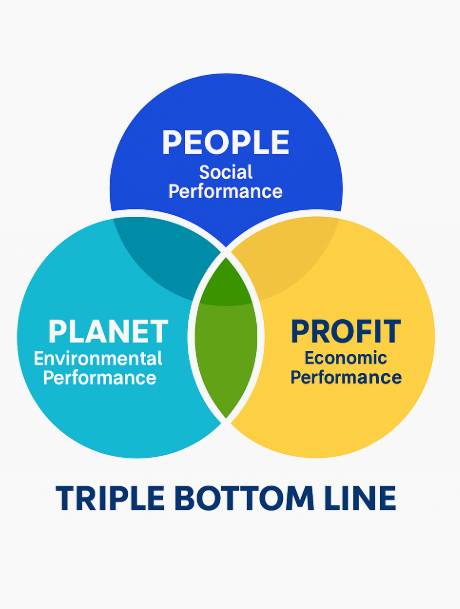
Shaping a New Business Paradigm
The rise of environmental awareness, social justice movements, and corporate accountability campaigns has prompted a shift in how organizations assess their contributions. Businesses are no longer judged solely by the numbers on a balance sheet but by how they affect the world around them. The Triple Bottom Line model offers a framework that captures this expanded view of business purpose.
Coined by sustainability expert John Elkington in the 1990s, TBL reimagines business success through three interconnected lenses: social welfare, environmental care, and financial viability. It reflects a new business philosophy—one that acknowledges a company’s role in shaping both communities and ecosystems, alongside generating profit.
Core Components of the Triple Bottom Line
At the heart of the TBL are three essential dimensions—often referred to as the three Ps: people, planet, and profit. These dimensions reflect the social, environmental, and economic responsibilities every business holds. Each plays a distinct role in shaping sustainable growth.
The Human Element: Social Responsibility
This dimension evaluates how a business affects people within and outside the organization. Social accountability goes beyond human resources—it encompasses everything from labor rights and fair wages to community engagement and diversity initiatives.
Companies with strong social commitments often invest in their workforce by providing safe working conditions, access to healthcare, equal opportunities, and upskilling programs. Externally, these companies support education, infrastructure, and health initiatives in local communities. Businesses that cultivate social capital build trust and loyalty, which can lead to long-term resilience.
The Environmental Perspective: Sustainability in Practice
Environmental responsibility focuses on how a company interacts with natural systems. This includes managing energy usage, reducing emissions, minimizing waste, conserving water, and ensuring sustainable sourcing of materials.
Organizations that take the ecological bottom line seriously often implement green policies, adopt renewable energy solutions, and redesign processes to reduce their environmental footprint. By prioritizing the planet, these businesses help mitigate climate risks, preserve biodiversity, and secure the resources needed for future operations.
The Economic Perspective: Profit Beyond the Balance Sheet
The financial component of the TBL remains vital but is viewed through a wider lens. It assesses how companies generate income while maintaining ethical practices and contributing to broader economic systems.
Rather than focusing solely on shareholder returns, TBL emphasizes stakeholder benefit. This includes providing living wages, supporting small suppliers, paying taxes transparently, and investing in innovation. Financial decisions are measured not just by their short-term returns but by their alignment with social and environmental objectives.
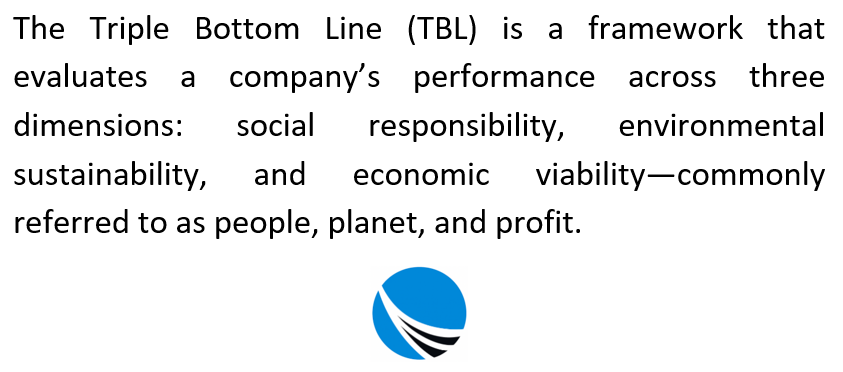
Why Companies Are Embracing the Triple Bottom Line
Global concerns—ranging from climate change to social inequality—have pushed companies to reconsider their priorities. Adopting the TBL framework allows organizations to adapt to these evolving expectations.
Today’s consumers favor ethical brands, investors demand ESG disclosures, and employees seek purpose in their work. TBL adoption responds to all of these drivers by promoting transparency, responsibility, and long-term thinking. Businesses that integrate TBL principles are better equipped to anticipate regulatory shifts, secure customer loyalty, and build sustainable growth pathways.
Tangible Advantages of the TBL Framework
Applying the Triple Bottom Line isn’t just an ethical choice—it offers concrete business advantages:
Stronger Workforce Loyalty
By valuing employee well-being, companies reduce turnover and improve morale. Offering meaningful work, equitable policies, and inclusive cultures helps attract and retain top talent. Employees are more productive when they feel respected and aligned with their employer’s values.
Positive Public Image
Companies that consistently show concern for environmental and social issues tend to enjoy better public relations. A reputation for doing good can attract customers, partners, and media attention—often translating into competitive advantage.
Operational Improvements
Sustainable practices like energy efficiency, material reuse, and reduced packaging often lead to cost savings. Companies can improve their bottom line while also reducing environmental impacts.
Community Engagement and Support
Businesses that give back to their communities tend to enjoy stronger local support. Whether through philanthropy or infrastructure investment, these efforts can open new markets and improve stakeholder relationships.
Practical Obstacles to Implementing TBL
Despite its appeal, the Triple Bottom Line approach is not without its hurdles.
Upfront Financial Costs
Transitioning to sustainable materials, revamping operations, or introducing new HR policies often demands significant investment. Many small businesses may struggle to justify the immediate costs, even if long-term gains are expected.
Difficulties in Measurement
While financial outcomes can be tracked precisely, the social and environmental impacts of a business are harder to quantify. How do you measure employee happiness or the long-term benefit of a tree-planting campaign?
Balancing Competing Priorities
Sometimes, the three pillars of TBL seem to compete. A company may face dilemmas such as whether to invest in green technology or increase wages. Aligning all three goals can be complex and often requires compromise.
Measuring TBL Performance: A Work in Progress
Quantifying triple bottom line outcomes remains one of the framework’s biggest challenges. While financial metrics are well understood, standardized methods for assessing social and ecological impact are still evolving.
Organizations like the Global Reporting Initiative (GRI) and B Lab offer templates and assessments that help businesses collect and interpret relevant data. These tools cover indicators such as carbon emissions, water use, labor practices, and supply chain ethics. The key is to measure what matters and remain transparent with stakeholders.
In some cases, businesses attempt to convert all three metrics into monetary values using cost-benefit analysis. Others prefer composite scoring systems that benchmark performance across multiple dimensions. Regardless of method, consistency and clarity are essential.
Expanding the TBL into a Future-Oriented Model
Some sustainability thinkers advocate adding a fourth dimension to the TBL framework—time. This concept, sometimes referred to as the Quadruple Bottom Line, considers how business decisions impact future generations.
By accounting for intergenerational equity, businesses are encouraged to think beyond quarterly profits and instead adopt strategies that ensure long-term prosperity. Time-based accountability reminds us that what we do today shapes tomorrow’s economic, social, and ecological realities.
Driving Innovation through TBL Values
The Triple Bottom Line isn’t just a reporting mechanism; it’s a launchpad for innovation. Businesses embracing this framework often lead the way in creating new products, services, and models that address pressing societal issues.
Examples include biodegradable packaging, upcycled fashion, microfinance platforms, or inclusive hiring practices. TBL-aligned innovation doesn’t just solve problems—it opens up new revenue streams and redefines what business success looks like.
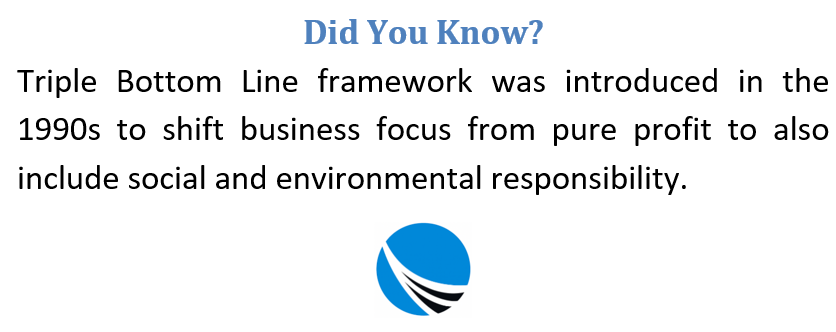
Examples of TBL in Action
Across industries, numerous companies have woven Triple Bottom Line principles into their operations:
Patagonia
The outdoor gear maker stands as a model for environmental activism and ethical business. Patagonia incorporates recycled materials, avoids toxic substances, and funds environmental restoration. It also supports employees with flexible work options and child care facilities.
Ben & Jerry’s
The ice cream brand integrates social advocacy into its mission, tackling issues from racial justice to climate change. It uses Fair Trade ingredients, pays a living wage, and engages in community outreach worldwide.
Interface
This global flooring company made sustainability the core of its business strategy. It has reduced its carbon footprint dramatically and aims for a closed-loop production system, where all products are recyclable.
Dr. Bronner’s
The soap company donates a large share of profits to charitable causes and campaigns for social and environmental justice. It also maintains full salary transparency and pays significantly above minimum wage.
Addressing Criticisms of the TBL Approach
While the Triple Bottom Line has gained traction, it is not without detractors. Some argue the model lacks rigor due to inconsistent measurement standards and the subjective nature of social outcomes.
Others claim that businesses use TBL as a marketing ploy—committing to sustainability on paper but not in practice. This form of reputational management, or “greenwashing,” undermines the integrity of the framework.
Critics also point out the difficulty of integrating three distinct dimensions into a single decision-making structure. Without firm enforcement or accountability mechanisms, it’s possible for companies to favor profit while neglecting the other two pillars.
Improving the TBL Model
To address these limitations, scholars and practitioners suggest various enhancements:
- Integrated Reporting: Unifying financial and non-financial disclosures into one comprehensive report.
- Third-Party Audits: Encouraging independent evaluations of social and environmental practices.
- Stakeholder Engagement: Involving employees, communities, and consumers in governance decisions.
- Clear Benchmarks: Developing industry-specific standards for sustainability metrics.
These improvements make the TBL approach more credible, actionable, and resistant to misuse.
Getting Started with the Triple Bottom Line
For companies new to the concept, the journey toward triple bottom line integration can begin with a few strategic steps:
Conduct a Sustainability Audit
Assess current operations to identify strengths, gaps, and opportunities across all three pillars. This baseline informs future goals.
Set Impact Goals
Define clear, measurable objectives for social, environmental, and financial outcomes. Establish timelines and track progress regularly.
Engage Your Workforce
Involve employees in shaping sustainability initiatives. Training programs, suggestion boxes, and recognition incentives can help foster engagement.
Communicate Transparently
Publish your goals and results through sustainability reports, websites, or social media. Open dialogue builds stakeholder trust and accountability.
The Long View: Business as a Force for Good
The Triple Bottom Line framework represents more than just a set of metrics. It’s a philosophical shift in how we view the purpose of business. No longer is success measured solely by profits—it’s about contributing to a healthier society and a more livable planet.
In an era marked by climate uncertainty, social unrest, and economic volatility, businesses have a choice. They can cling to outdated models focused solely on financial gain, or they can embrace a vision of shared prosperity. The Triple Bottom Line provides a practical pathway to that future—one where business success and social progress go hand in hand.
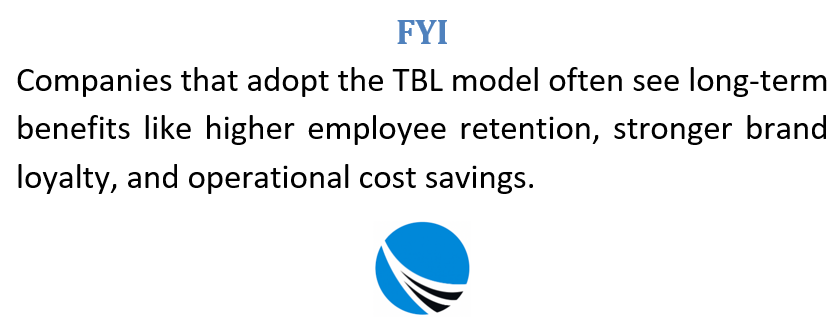
FAQs about TBL
Why was the Triple Bottom Line developed?
TBL was developed to move beyond traditional profit-only metrics and reflect a broader view of business impact. It helps organizations assess how their operations affect society and the environment alongside financial outcomes.
Who introduced the concept of the Triple Bottom Line?
The concept was introduced by sustainability expert John Elkington in the 1990s as a way to redefine corporate accountability and promote long-term sustainable business practices.
How does the “people” aspect of TBL work?
This dimension focuses on a business’s impact on individuals and communities, including fair labor practices, diversity, community engagement, and employee well-being.
What does the “planet” pillar emphasize?
The planet component addresses environmental impact, encouraging companies to minimize resource consumption, reduce waste, limit emissions, and protect ecosystems.
How is profit viewed under the TBL framework?
Profit is still important, but under TBL, it is considered alongside ethical practices and long-term sustainability. The focus shifts from short-term financial gain to shared economic value.
What are the benefits of adopting TBL?
TBL can lead to stronger brand loyalty, employee retention, cost savings through resource efficiency, and a positive reputation among stakeholders and consumers.
What challenges come with using TBL?
Challenges include difficulty in measuring social and environmental outcomes, upfront costs for sustainable initiatives, and balancing priorities among the three pillars.
How do businesses measure TBL performance?
Companies use key performance indicators (KPIs), sustainability audits, third-party tools like the B Impact Assessment, and sometimes financial proxies or scoring systems for social and ecological outcomes.
Can the TBL be expanded?
Yes, some experts propose a “Quadruple Bottom Line” by adding a time dimension that considers long-term and intergenerational impacts of today’s business decisions.

